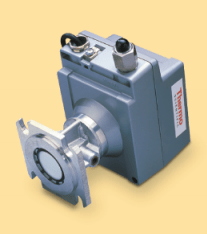DISCONTINUED: SEE THE FNR131 FOR REPLACEMENT

The Thermo Scientific Ramsey Granuflow DTR 131 and DTR 231 detect and monitor flow/no-flow conditions of bulk solids. Real-time flow data from the detectors allows you to monitor processes closely, leading to increased reliability, higher quality end product, reduced downtime and fewer hazards to jeopardize operators and equipment.
The Thermo Scientific Ramsey Granuflow DTR 131 and DTR 231 are low-cost, non- invasive, microwave-based instruments
that detect and monitor flow/no-flow conditions of bulk solids on conveyor belts,
in pipelines, ducts and air-slides, as well as at transfer points of chutes, conveyor belts and bucket elevators. Used for automation purposes, they efficiently optimize the use
of machinery and energy by switching process equipment on or off as required.
The RamseyTM Granuflow DTR 131 and DTR 231 have no moving mechanical parts, which eliminates wear and makes the instruments maintenance-free and trouble-free.
Principle of Operation
The Ramsey Granuflow DTR 131 and DTR 231 utilize the Doppler Effect. They measure the difference between emitted and reflected microwave frequencies. Their electronics emit a signal that is reflected by moving material. When the material is in motion,
the returned signal is either higher or lower in frequency than the transmitted signal. No motion is present if the returned signal is the same frequency as the transmitted signal. Changes in the received microwave energy, due to things such as build-up in front of the antenna, do not affect flow/ no-flow detection.
These detectors produce microwave energy at a level of 0.15 mW/cm2 (measured at the antenna horn), which is a much lower level than the international safety standard of
10 mW/cm2. They are certified to FCC-15F.
Detection Through Walls
Microwaves can penetrate non-conductive materials, such as plastic, glass and wood with negligible attenuation; therefore, the Ramsey Granuflow DTR 131 and DTR 231 are capable of looking into the process through thick walls. Non-conductive build-up on a wall of the container does not affect the signal, allowing easy installation. External mounting lets the process remain closed. It also permits detection from the safe area outside of a hazardous process or high pressure-high temperature system. If an application requires penetration of conductive material, a window can be installed to allow the unit to see into the process.
The adjacent table gives the values of wall thickness for various materials, which attenuate the intensity of the microwaves by half. Ramsey Granuflow DTR 131 and DTR 231 sensors can detect flowing conditions even when only a small percentage of their emitted microwave energy is available.
The Sensing Beam
A detector’s microwave antenna emits and receives continuously. Its beam’s narrow shape allows precise placement of the sensor, protecting the system against false readings caused by movement outside of the process. The beam can detect Doppler frequencies of 1.6 Hz up to 1.6 kHz, which corresponds to a solids velocity of 13 mm/sec to 9.75 m/sec (0.5 in/sec to 32 ft/sec) or lower, depending on the application.







